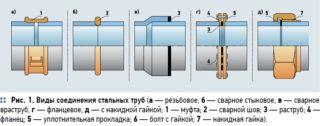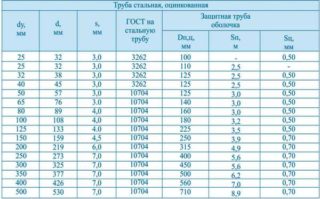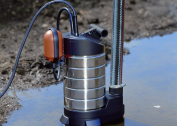Steel pipes surpass similar products made of other materials in terms of strength, resistance to temperature and pressure. The application of an anti-corrosion layer extends the life of galvanized water pipes.
Regulatory requirements
Galvanized pipes are used to summarize communications, technological systems with hot and cold water, steam, gas in aggressive environments. The metal water pipe quickly rusts under the influence of water with oxygen dissolved in it. The external parts of the system corrode in contact with moist air and condensate.
VGP pipe is made of black steel in accordance with GOST 3262-75. The finished product is galvanized, which increases the service life of water supply systems. A zinc layer, at least 30 microns thick, protects the inner and outer surfaces of the steel from moisture and atmospheric oxygen. In this case, the weight of the pipe increases by 3%.
The state standard regulates the following requirements for the production of galvanized pipes:
- products are made of steel tape by applying an electric-welded longitudinal seam with a leak test;
- conditional pass - ДУ, approximately equal to the inner diameter and corresponds to the size of the connected section;
- pipe curvature not more than 2 mm per linear meter with DN 20 and 1.5 mm for large diameters;
- the length of straight sections varies from 4 to 12 meters;
- products are manufactured with threaded or knurled threads;
- the absence of a protective layer on the thread and the ends of the segments is allowed;
- working pressure according to GOST from 25 to 32 kgf / cm2, depending on the type.
The operating standards for cold water supply are 30 years, hot - 20, while ordinary steel pipes serve, respectively, 15 and 10 years. In 90% of cases, the weld is the cause of leakage in a smooth section of the pipe.
Types and specifications
Depending on the application, the pipes are water-gas, electric-welded and profile. The galvanized pipe for water supply in accordance with GOST can have standard and increased manufacturing accuracy.
The product range is distinguished by conditional passage, outer cross-section, wall thickness and weight. According to the conditional passage, the size varies from 6 to 150 mm, and the outer section can be 10.2–165 mm.
Depending on the wall thickness, the products are divided into light, ordinary and reinforced. For all types of remote controls the same. The inner diameter depends on the wall thickness. In light products, it is the largest, in the strengthened minimum. The thicker the walls, the higher the rust protection.
The corrosion process is accelerated during periodic shutdowns of water supply, when there is a discharge of water, and its place is occupied by moist air.
Pipe selection criteria
For consumers, bandwidth and working pressure are important. The lower the pressure in the system, the greater the conditional pass. For an internal domestic water supply system, a pipe with a cross section of 20 mm is enough.
The dimensions of the walls are selected depending on the technological requirements of the laid lines. At the same time, it is taken into account that ordinary and light bends are designed for an operating pressure of 25 kgf / cm2, and reinforced up to 32 kgf / cm2.
Galvanized products are 50-60% more expensive than ordinary pipes. Pricing is formed on the basis of steel grade, product mix, product quality, manufacturer. The price per meter of galvanized pipes for water supply with a 15 mm remote control and a wall thickness of 2.8 mm starts at 70 rubles.
The cost varies depending on the region of implementation. Retail price is higher than wholesale.A ton of metal can approximately cost from 48,791 rubles. Based on the calculation that the weight of 1 p / meter of galvanized ordinary VGP 15x2.8 pipe is 1.28 kg, 781 linear meters of pipe per ton.
Before buying, you must familiarize yourself with the certificate of conformity and product specifications.
Methods of connection and installation
 For connection, threaded docking and welding are used. For installation, it is better to use the services of an experienced plumber. A galvanized weld was previously considered unacceptable. Under the influence of temperature, the zinc evaporated, which could harm the working body. In addition, the junction lost the protective coating.
For connection, threaded docking and welding are used. For installation, it is better to use the services of an experienced plumber. A galvanized weld was previously considered unacceptable. Under the influence of temperature, the zinc evaporated, which could harm the working body. In addition, the junction lost the protective coating.
The welding method is used to assemble all types of round pipes. Apply gas or electric arc welding. For the latter, rutile coated electrodes are preferred. The main difficulty is to prevent the burnout of the protective layer. For this, the junction is covered with a welding flux. In this case, zinc melts, but does not burn. Residues are washed away by a stream of water.
Threaded mounting requires precise fitting of nozzles and elbows. Bends are pre-prepared by cutting pipes to the desired size. The edges are filed. Manual threading is a laborious process and requires special tools. Work is simplified if you use a lathe. It is better to paint the thread, otherwise it will quickly rust.
Tubular products with thread at the ends, applied at the factory, after diffuse galvanizing are ready for threaded connection. Installation is carried out using galvanized parts - these are couplings, nipples, reductions, angles, plugs. Joints are sealed with tow with paint. It can be replaced with fum tape or thread sealant.
The docking made in accordance with all the rules is tight and safe, resistant to corrosion. Such a connection is easily dismantled during repair or for subsequent replacement.
Advantages and disadvantages
 Products are used in housing and communal services outside and indoors. They are used for laying water pipes in a private house, cottage or bathhouse, in cold open warehouses. Among the advantages are the following:
Products are used in housing and communal services outside and indoors. They are used for laying water pipes in a private house, cottage or bathhouse, in cold open warehouses. Among the advantages are the following:
- strength and fire resistance;
- does not overgrow with mineral deposits and rust;
- a low coefficient of thermal expansion is important if the pipe is recessed into the screed;
- the ability to install and repair with your own hands;
- use as a heat exchanger.
With uninterrupted supply in the cold water supply system, drinking water is safe for humans. The maximum allowable concentration of zinc is not higher than 5 mg / liter, while the allowable daily allowance for the body is 10-15 mg.
Zinc is a toxic metal. Accumulating in the body can cause serious poisoning. Using galvanized pipes to equip the water main, you need to think about safety, use proven and high-quality materials.
The disadvantage is the large specific gravity and electrical conductivity. High heat dissipation requires pipe insulation in heating and domestic hot water.
Temperature fluctuations during hot water supply reduce anti-corrosion properties. At 60 ° –80 °, zinc reverses polarity. A cathodic porous coating forms, and ulcerative corrosion occurs. The service life of such a pipe is reduced. For domestic hot water and heating use products that have only an external protective coating.
The service life of water pipes with galvanized pipes depends on the quality and chemical characteristics of the water. They are not used when installing wells. The lack of water exchange promotes chemical reactions that degrade water quality.




